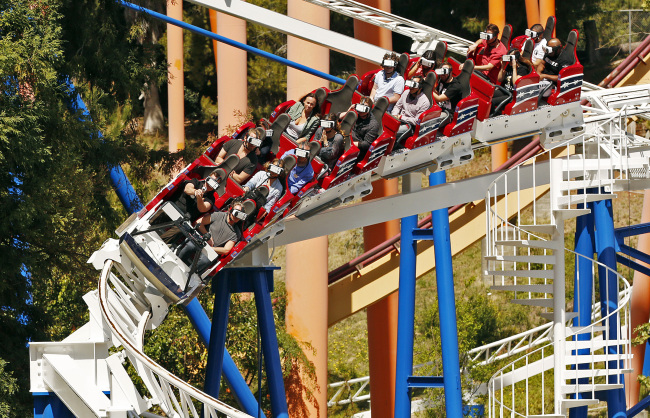LOS ANGELES -- When Walt Disney opened his famed Anaheim park in 1955, he turned to corporate sponsors to keep construction and operation costs under budget.
That helps explain why two of the original attractions were the less-than-thrilling Monsanto Hall of Chemistry, sponsored by the agrochemical giant, and the Aluminum Hall of Fame, sponsored by Kaiser Aluminum.
“It was just as bad as it sounds,” said David Koenig, author of several books on Disney.
More than 60 years later, sponsorships are on the rise throughout the theme park industry. Brands including Honda, Alamo and Coca-Cola are spending big money to get the attention of amusement park visitors, with approaches that range from subtle to screaming.
“Theme parks have always been associated with sponsors in one way or another,” said William Chipps, senior content editor for IEG, a consulting firm that tracks sponsorship spending. “And we are seeing sponsorship growing in popularity.”
Sponsorship spending at theme parks and other entertainment businesses in North America is projected to reach $2.22 billion this year, according to IEG, up 15 percent since 2012. For some theme parks, corporate sponsorships are responsible for as much as 5 percent of their overall revenue.
Sponsorship deals vary widely, but Chipps said a typical multipark contract could cost a sponsor “high six figures to low seven figures.”
Sponsorships at theme parks are on the rise partly because park attendance has been growing in the U.S., with Disney and Universal Studios reporting record attendance in the last year.
Theme parks are also popular with sponsors because they represent a good place to reach the growing number of young parents -- consumers with healthy disposable incomes.
“You name the brands, and they want to reach out to millennials, teens and young families,” said Matt Shafer, corporate vice president of strategic alliances for Cedar Fair, the parent company of Knott’s Berry Farm in nearby Buena Park.
 |
Samsung is a sponsor of the New Revolution at Six Flags Magic Mountain, a roller coaster that puts virtual reality goggles on riders so they can get a sensation of flying through space. (Los Angeles Times/TNS) |
Another reason for the sponsorship growth is what Chipps calls the “halo effect.” Sponsors believe that when guests have a good time at a theme park, that positive feeling will extend to the sponsors of rides and attractions.
“Sponsors want to align with events and attractions that people are passionate about,” he said.
Representatives for Coca-Cola, one of the largest sponsors of U.S. theme parks, agree.
“Theme parks create a unique environment where friends and families come together and make lasting memories, experience joy and excitement,” said Stefanie Miller, vice president of global strategic partnership marketing at Coca-Cola North America. “We take great pride in being a part of special moments like these.”
But industry experts and park guests say theme parks can go overboard by plastering their rides and landscaping with corporate ads and logos.
Kurt Dahlin, a longtime roller coaster enthusiast from Santa Clarita, north of Los Angeles, rode a roller coaster a few years ago at Six Flags Magic Mountain in Valencia that he said was wrapped in an ad for hair gel.
“It was hideous,” he said. “It was a rolling billboard. I think that is taking it a little too far.”
Martin Lewison, a theme park expert and business management professor at Farmingdale State College in New York, said sponsorship ads should not draw too much attention to themselves or distract from the fun guests are having at a theme park.
But he noted that a few years ago, a roller coaster called the Georgia Scorcher at Six Flags over Georgia was sponsored by Georgia Natural Gas. The ride’s slogan was “Put Your Feet to the Fire.”
“Some people are going to be turned off, and some people won’t even notice” the sponsors, Martin said.
Six Flags Entertainment, the parent company of Six Flags Magic Mountain and Six Flags over Georgia, takes sponsorship to a level that most other theme park companies don’t.
At Six Flags Magic Mountain, the park’s official credit card is Discover. Snickers has sponsored the annual Halloween event, and a funicular people-mover at the park recently has been sponsored by Honda. The park even has an official cheese sauce: Ortega.
Samsung recently became the sponsor of the New Revolution roller coaster at Six Flags. The Korean conglomerate manufactures the virtual reality goggles that riders wear to get an outer-space experience while riding the roller coaster.
“We’ve actually seen a lot of growth in our department,” said Stephanie Borges, vice president of North American strategic marketing for Six Flags Entertainment.
She rejected suggestions that Six Flags uses sponsors excessively.
“We focus on the quality more than the quantity,” Borges said.
In 2015, sponsorships, licensing and other fees generated $59 million for Six Flags Entertainment -- nearly 5 percent of the company’s total revenue. Since 2011, sponsorships, licensing and other fees have increased 40 percent at Six Flags Entertainment, the company reported.
Universal Studios Hollywood and Disneyland do a better job of keeping sponsorship ads and promotions from overwhelming guests, Lewison said.
“Disney is a high-end park that has a history of doing it, but doing it in a tasteful way,” he said. (Tribune Content Agency)
By Hugo Martin
Los Angeles Times








